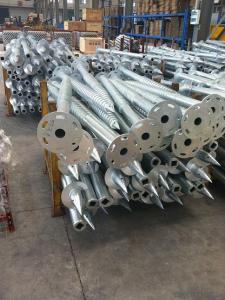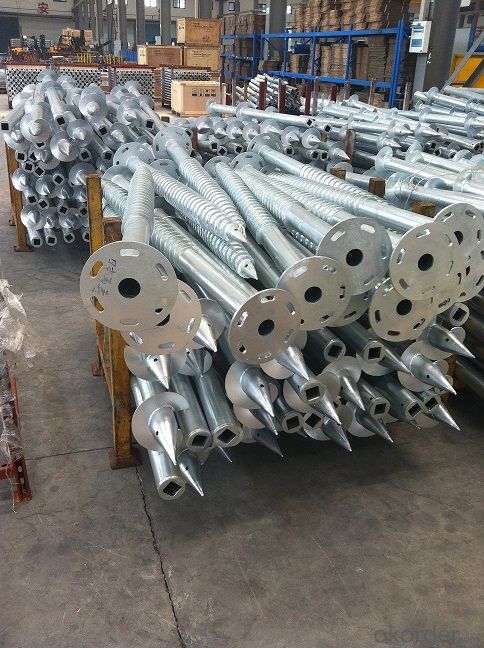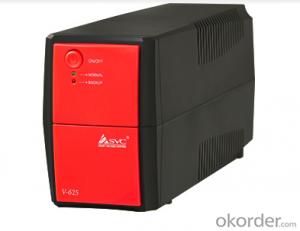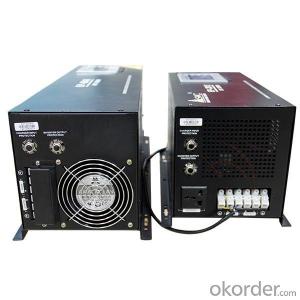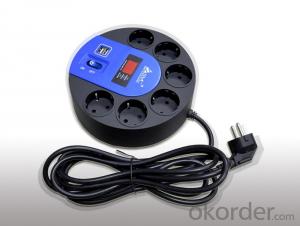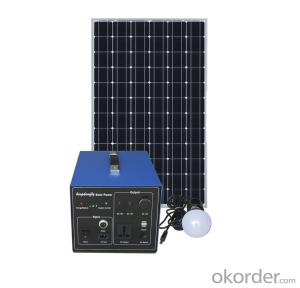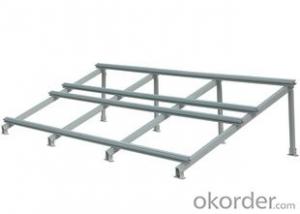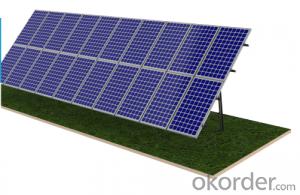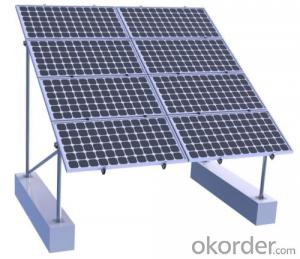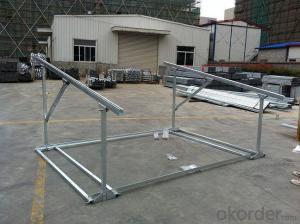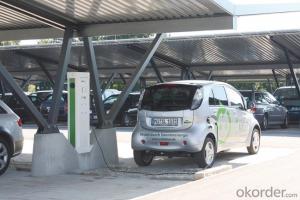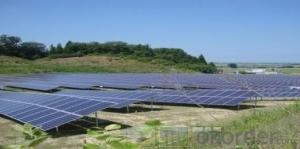Pv Max Solar Energy Systems - Ground System Solar Mounting System
- Loading Port:
- China Main Port
- Payment Terms:
- TT OR LC
- Min Order Qty:
- -
- Supply Capability:
- -
OKorder Service Pledge
OKorder Financial Service
You Might Also Like
Packaging & Delivery
Packaging Detail:Normal package seaworthy
Delivery Detail:15 days
Specifications
Easy installation Competitive price TUV&SGS test report & CSA certification 15-warranty
Specifications
1) Super smooth beautiful appearance,outstanding quality,large supply.
2) Available in customized surface finishes.
3) Well machined,for example,cutting,drilling and milling with excellent tolerance.
4) Meet with customer’s designs and supply you best price.
5)Usages:Supply for solar panel modules.
Technical characteristics
Installation site:
ground,hillside,and grassland
Installation angle
it is based on customers’ requirements
Installation height
it is basedon customers’ requirements
Solar panel type; with or without frame
Components arrangement :horizontal or vertical
Support track
aluminum alloy extrusion
Quality warranty
15 years
Advantages
1)Quick installation: with high degree of pre-installed rate, the system could be easily installed by using galvanized carbon steel rails for PV Stent, and specially designed connection parts of the PV bracket, which could reduce installation time and cost greatly.
2)Offer unmatched durability: with all structural components comprised of high class stainless steel and anodized aluminum alloy, it is designed for 25 years service life and backed by 15 years warranty.
3)Stand up to extreme weather: The SuninTek solar mount is designed to stand up to the extreme weather complied with the AS/NZ 1170 and other international structure load standard by the skilled engineer. The main support components also have been tested to guarantee its structure and load-carrying capacity.
4)Provide broad installation flexibility: These systems accommodate most commercially available framed solar panels , and they can scale easily from small to large, multi-megawatt installations.
5)Diversified Application: The PV mounting system produced can be adopted by various types of PV cells panels which you can find in the market. It can serve for both mini solar power system and huge plant with megawatt capability.
Main features
1. Installation cost savings.
2. Save installation time.
3. Increase the mechanical strength of solar energy mounting to ensure that wind requirements.
4. The outdoor for installation of solar energy.
5. Length can be customized according to customers.
6. Service life of up to 25 years.
7. Products through the international certification.
8. Stent material composition of the galvanized steel and aluminum.
9. 15 years system and structural guarantee.
10.Flexible post spacing withstands different wind & snow loads.
11. High quality material in Aluminium 6005-T5 and SUS 304.
12.Screws and nuts go with every components needed.
13.Mechanical calculation and reliability tested to ensure highest product quality.
- Q: How do solar energy systems impact the value of a property?
- There are several ways in which solar energy systems can positively affect the value of a property. To begin with, the installation of a solar energy system can lead to a significant reduction or complete elimination of electricity bills, which is an appealing feature for potential buyers. This can result in substantial long-term savings, making the property more attractive and financially advantageous. Furthermore, solar energy systems are considered to be a sustainable and environmentally friendly solution. As the demand for clean energy continues to rise, properties with solar panels are seen as more desirable and forward-thinking. Buyers are increasingly seeking eco-friendly features, and the presence of a solar energy system can set a property apart from others on the market. Additionally, solar energy systems often come with government incentives and tax credits, which can further enhance the value of a property. These financial incentives can offset the initial cost of installing the system and provide additional savings for the homeowner, making the property more appealing to potential buyers. Moreover, solar energy systems can also contribute to a property's resilience during power outages or grid failures. By utilizing a backup battery system, homeowners can continue to generate and store electricity, ensuring a reliable power supply. This can be a valuable asset, particularly in areas that are prone to blackouts or natural disasters, and can increase the desirability and value of the property. Lastly, studies have shown that homes equipped with solar energy systems tend to sell faster and at higher prices compared to homes without such systems. Research conducted by the U.S. Department of Energy's Lawrence Berkeley National Laboratory revealed that solar homes sold for an average of 4.1% more than non-solar homes. This clearly illustrates the positive impact that solar energy systems can have on property value. In conclusion, solar energy systems can have a significant impact on the value of a property by reducing electricity bills, showcasing sustainability, providing financial incentives, offering backup power, and increasing the speed and price of property sales. As renewable energy becomes increasingly mainstream, solar energy systems are viewed as valuable and desirable assets in the real estate market.
- Q: How does the efficiency of solar panels affect a solar energy system?
- The efficiency of solar panels directly impacts the overall performance and cost-effectiveness of a solar energy system. Higher efficiency panels can generate more electricity from the same amount of sunlight, allowing the system to produce more power. This can result in a higher return on investment and shorter payback periods. Additionally, more efficient panels require less space, making them suitable for installations where space is limited. Conversely, lower efficiency panels may require more space and installation costs to achieve the desired energy output. Therefore, the efficiency of solar panels plays a crucial role in optimizing the performance and economic viability of a solar energy system.
- Q: Can a solar energy system be used in areas with high levels of air pollution?
- Indeed, areas with high levels of air pollution can still utilize solar energy systems. Although the efficiency of solar panels may be diminished by air pollution, it does not completely impede their ability to generate electricity. In polluted regions, solar energy systems continue to operate and produce power. It is worth mentioning, however, that the system's efficiency may be slightly reduced due to the decreased amount of sunlight reaching the panels. Regular cleaning and maintenance of the solar panels can help alleviate the impact of air pollution on their performance. Furthermore, advancements in solar technology are being pursued to enhance panel efficiency in polluted environments. For instance, anti-soiling coatings are being developed to prevent dust and pollutants from adhering to the panels. Overall, even in areas with substantial air pollution, solar energy systems remain a feasible and sustainable source of electricity.
- Q: How does the efficiency of solar panels vary across different manufacturers?
- Solar panels can indeed exhibit varying levels of efficiency depending on the manufacturer. There are multiple factors that contribute to this variability. To begin with, the efficiency of solar panels can be greatly influenced by the quality and type of materials utilized during production. Manufacturers often employ different types of silicon, such as monocrystalline or polycrystalline, which possess differing efficiency levels. Monocrystalline silicon panels generally outperform their polycrystalline counterparts in terms of efficiency. The manufacturing processes employed by different companies can also impact the efficiency of their solar panels. Manufacturers with more advanced and precise techniques are capable of producing panels with higher efficiency. This encompasses factors such as the thickness of the silicon layers, the quality of anti-reflective coatings, and the precision of cell alignment. Research and development efforts also play a significant role in enhancing the efficiency of solar panels. Certain manufacturers heavily invest in research to develop new technologies and techniques that improve panel efficiency. This often leads to the creation of more efficient solar cells and an overall improvement in panel performance. Furthermore, the efficiency variation among different manufacturers can be attributed to product design and engineering. Some companies prioritize optimizing panel design to maximize light absorption and minimize energy losses, resulting in higher efficiency. This includes aspects such as the number and arrangement of cells, the size and spacing of busbars, and the integration of bypass diodes. The level of quality control and testing procedures implemented by manufacturers can also impact panel efficiency. Manufacturers that adhere to strict quality control measures and comprehensive testing protocols are more likely to produce panels with higher efficiency rates. This enables them to identify and minimize any defects or issues during the production process. Additionally, it is important to consider that the efficiency of solar panels can also be influenced by external factors like temperature, shading, and orientation. Different manufacturers may have varying levels of tolerance to these external factors, resulting in different performance levels under real-world conditions. In conclusion, the efficiency of solar panels can vary across different manufacturers due to factors such as material quality, manufacturing processes, research and development efforts, product design, quality control, and external factors. Consumers should take these factors into consideration when comparing solar panels from different manufacturers to ensure they select the most efficient option for their specific needs.
- Q: Do solar energy systems work at night?
- At night, solar energy systems are unable to function due to their reliance on sunlight for the generation of electricity. Through the photovoltaic effect, solar panels transform sunlight into electricity by dislodging electrons from atoms with photons from the sun's rays, thus establishing an electric current. The absence of sunlight results in the absence of an energy source to sustain the system. Nevertheless, it is important to note that certain solar energy systems possess the capability to store surplus energy generated during the day in batteries, enabling the utilization of this stored energy for operating appliances or lighting during the night.
- Q: Can solar energy systems be used in powering banks or financial institutions?
- Yes, solar energy systems can definitely be used to power banks or financial institutions. In fact, many banks and financial institutions worldwide are adopting solar energy systems as a sustainable and cost-effective solution for their power needs. Solar energy systems consist of photovoltaic (PV) panels that convert sunlight into electricity. These panels can be installed on the rooftops or open spaces surrounding banks and financial institutions. The generated electricity can then be used to power various operations within these institutions, including lighting, air conditioning, computers, ATMs, and other electronic devices. There are several reasons why solar energy systems are advantageous for banks and financial institutions. Firstly, they provide a reliable and continuous source of electricity, reducing the dependence on the traditional power grid. This ensures uninterrupted operations and minimizes the risk of power outages, which is critical for financial institutions that need to maintain constant access to their systems. Furthermore, the use of solar energy helps banks and financial institutions reduce their carbon footprint and contribute to environmental sustainability. By utilizing renewable energy, they can significantly reduce greenhouse gas emissions and help combat climate change. This aligns with the increasing focus on corporate social responsibility and sustainable practices among businesses. Additionally, solar energy systems provide long-term cost benefits. While the initial installation cost may be higher compared to traditional energy sources, solar systems have low operating and maintenance costs. Over time, the savings on electricity bills can be substantial, allowing banks and financial institutions to allocate those funds towards other investments or initiatives. Moreover, the installation of solar panels can enhance the reputation and branding of banks and financial institutions. By visibly demonstrating their commitment to renewable energy, they can attract environmentally conscious customers and investors who value sustainable practices. In conclusion, solar energy systems are highly suitable for powering banks and financial institutions. They offer a reliable, sustainable, and cost-effective solution, allowing these institutions to meet their power needs while reducing their environmental impact and enhancing their reputation in the market.
- Q: Can solar panels be installed on RVs or boats?
- Yes, solar panels can be installed on both RVs and boats. In fact, they are becoming increasingly popular as a sustainable and efficient way to generate electricity while on the move. Solar panels can provide a reliable source of power for various appliances and equipment used in RVs and boats, such as lights, fans, refrigerators, and even charging electronic devices. The panels are typically mounted on the roof or deck, where they can capture sunlight and convert it into usable energy. This allows RV and boat owners to reduce their reliance on traditional power sources and have greater freedom to explore remote areas without the need for electrical hookups. Additionally, solar panels on RVs and boats are environmentally friendly and can help reduce carbon emissions. However, it is important to consider the power requirements and available space before installing solar panels, as well as ensuring proper installation and maintenance to maximize their efficiency and longevity.
- Q: Can solar energy systems be installed on roofs?
- Yes, solar energy systems can be installed on roofs. In fact, rooftops are one of the most common locations for solar panel installations, as they offer ample space and direct access to sunlight. This allows for efficient harnessing of solar energy to generate electricity or heat water.
- Q: Can solar energy systems be integrated into building materials, such as solar roof tiles?
- Solar energy systems can indeed be incorporated into building materials, and one popular instance of this is the utilization of solar roof tiles. These tiles, also referred to as solar shingles or solar slates, have been meticulously designed to resemble conventional roofing materials while simultaneously harnessing solar energy. Constructed with photovoltaic cells that convert sunlight into electricity, these specialized tiles have numerous advantages over traditional solar panels. One of the primary benefits of solar roof tiles is their seamless integration with a building's overall aesthetics, resulting in a more visually appealing structure. This harmonious blend into the building's structure allows for a more cohesive design, particularly in regions where stringent architectural guidelines are in effect. Moreover, solar roof tiles can be installed on both new and existing buildings, providing a flexible and adaptable solution. Another advantage of solar roof tiles lies in their ability to generate electricity while exhibiting durability and resistance to harsh weather conditions. These tiles are specifically designed to withstand various elements, including rain, snow, and wind. Additionally, solar roof tiles are typically manufactured using high-quality materials, ensuring a longer lifespan compared to traditional roofing materials. The integration of solar energy systems into building materials, exemplified by solar roof tiles, offers a multitude of benefits. Not only do they generate clean and renewable energy, but they also contribute to reducing reliance on fossil fuels and decreasing carbon emissions. Additionally, solar roof tiles can assist in reducing energy costs by generating electricity on-site, enabling homeowners and businesses to achieve greater energy independence. In summary, solar energy systems can indeed be incorporated into building materials, and solar roof tiles serve as a prime example of this. With their visually appealing appearance, durability, and capacity to generate energy, solar roof tiles present a promising solution for harnessing solar power while simultaneously preserving the architectural integrity of a building.
- Q: Can a solar energy system be installed in areas with high humidity?
- Yes, a solar energy system can be installed in areas with high humidity. While high humidity can affect the efficiency of solar panels to some extent, it does not completely prevent the installation or functioning of solar energy systems. The performance of solar panels is primarily influenced by the amount of sunlight they receive rather than humidity levels. However, it is important to note that excessive humidity or moisture can potentially lead to corrosion or damage to the electrical components of the system. Therefore, proper precautions and maintenance should be undertaken to ensure the longevity and optimal performance of the solar energy system in high humidity areas.
Send your message to us
Pv Max Solar Energy Systems - Ground System Solar Mounting System
- Loading Port:
- China Main Port
- Payment Terms:
- TT OR LC
- Min Order Qty:
- -
- Supply Capability:
- -
OKorder Service Pledge
OKorder Financial Service
Similar products
Hot products
Hot Searches
Related keywords
